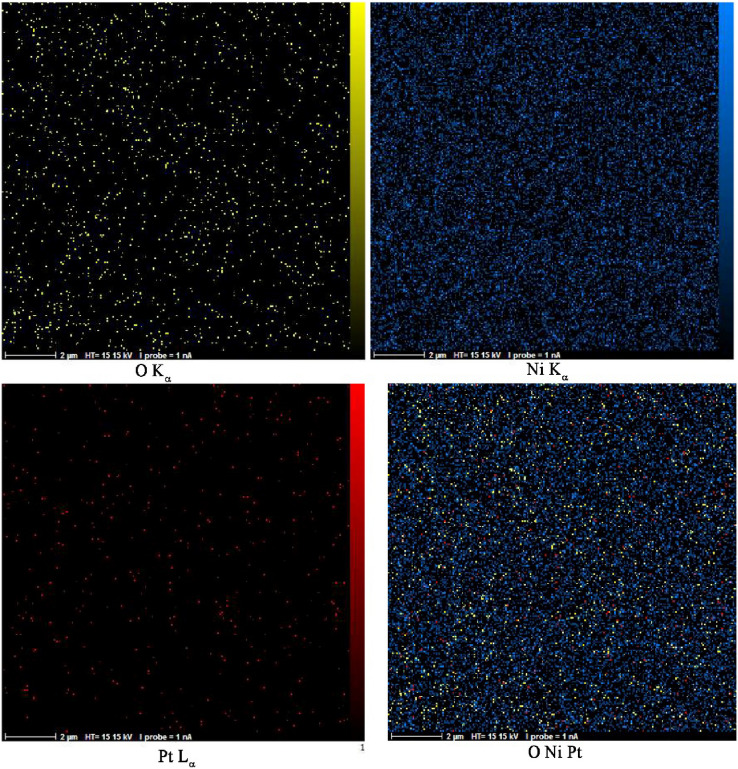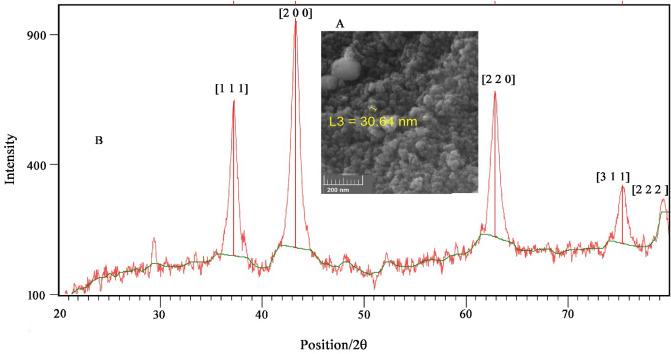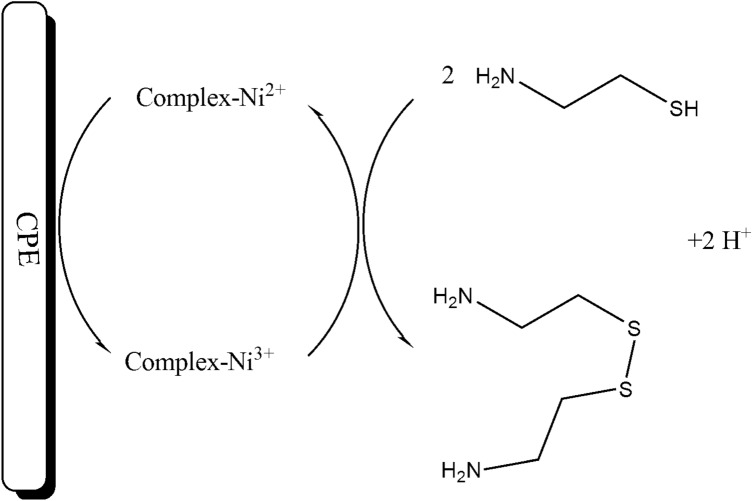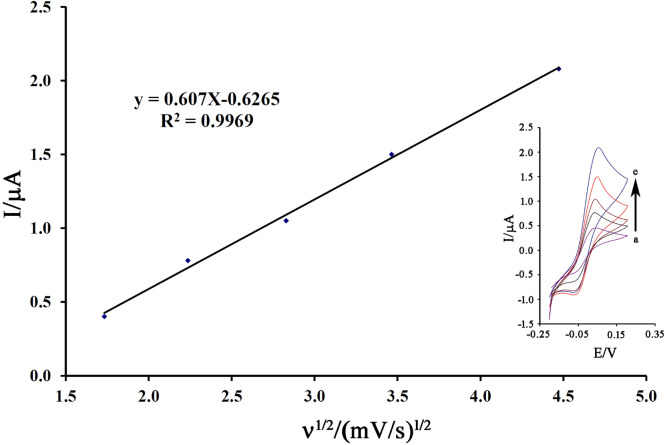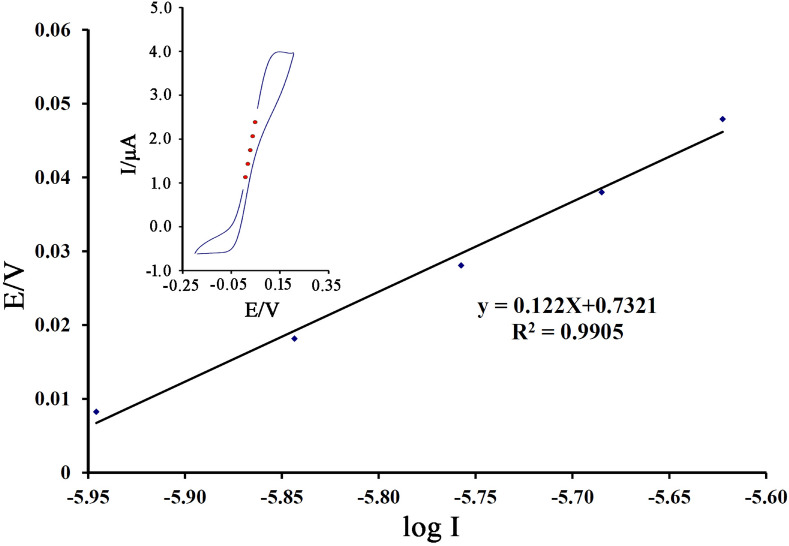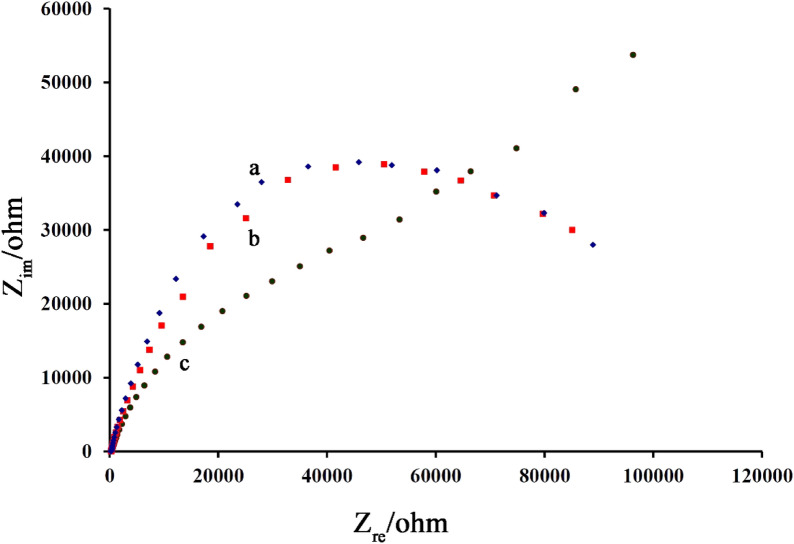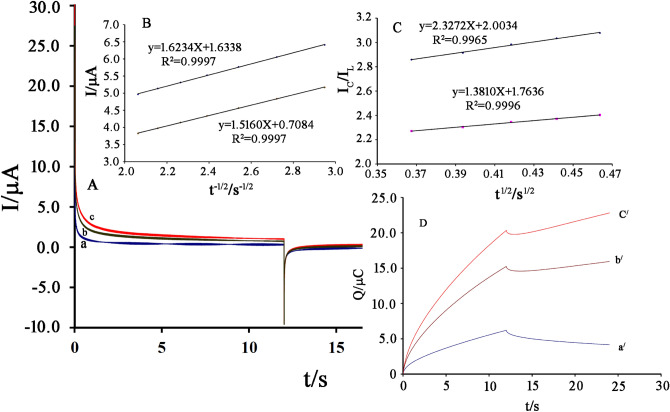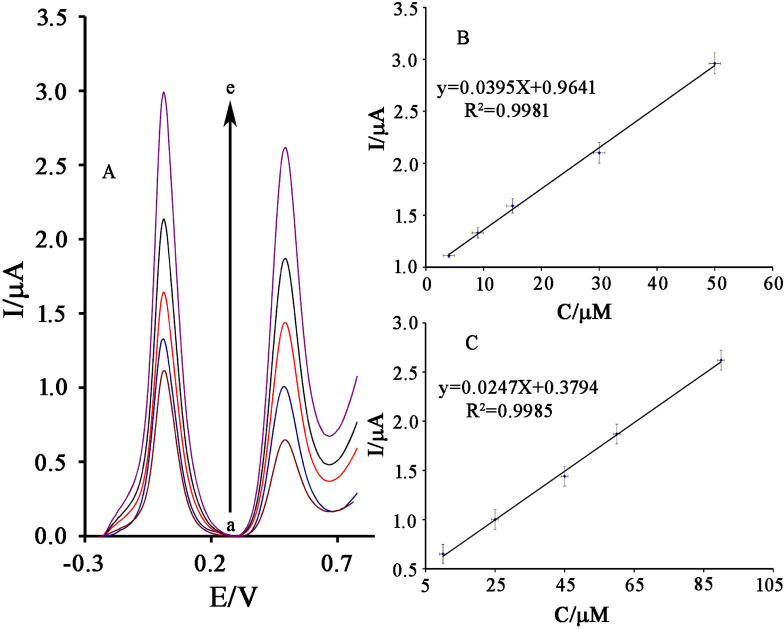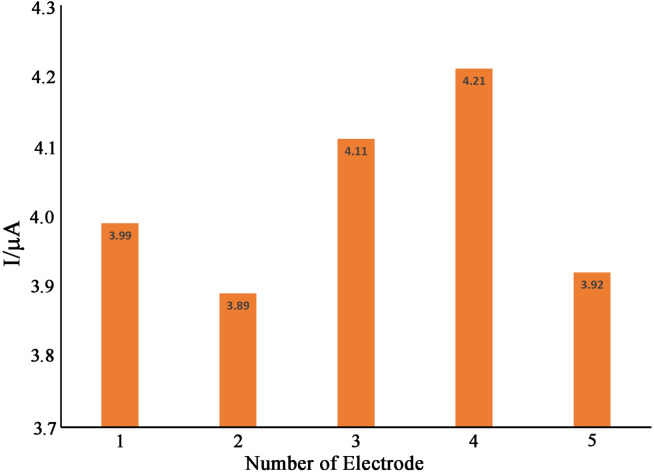Abstract
A highly sensitive electrocatalytic sensor was designed and fabricated by the incorporation of NiO dope Pt nanostructure hybrid (NiO–Pt–H) as conductive mediator, bis (1,10 phenanthroline) (1,10-phenanthroline-5,6-dione) nickel(II) hexafluorophosphate (B,1,10,P,1,10, PDNiPF6), and electrocatalyst into carbon paste electrode (CPE) matrix for the determination of cysteamine. The NiO–Pt–H was synthesized by one-pot synthesis strategy and characterized by XRD, elemental mapping analysis (MAP), and FESEM methods. The characterization data, which confirmed good purity and spherical shape with a diameter of ⁓ 30.64 nm for the synthesized NiO–Pt–H. NiO–Pt–H/B,1,10, P,1,10, PDNiPF6/CPE, showed an excellent catalytic activity and was used as a powerful tool for the determination of cysteamine in the presence of serotonin. The NiO–Pt–H/B,1,10, P,1,10, PDNiPF6/CPE was able to solve the overlap problem of the two drug signals and was used for the determination of cysteamine and serotonin in concentration ranges of 0.003–200 µM and 0.5–260 µM with detection limits of 0.5 nM and 0.1 µM, using square wave voltammetric method, respectively. The NiO–Pt–H/B,1,10,P,1,10,PDNiPF6/CPE showed a high-performance ability for the determination of cysteamine and serotonin in the drug and pharmaceutical serum samples with the recovery data of 98.1–103.06%.
Subject terms: Bioinorganic chemistry, Biochemistry, Chemistry, Materials science, Nanoscience and technology
Introduction
Cysteamine is a simple aminothiol with a variety of medicinal applications used to treat various diseases such as cystinosis and hypothyroidism1. Cysteamine is prescribed as a radiation-protective agent drug to treat radiation sickness2. Overdose of cysteamine brings about many side effects such as dizziness, rash, skin odor, headache, and tiredness. Therefore, the analysis of cysteamine should be monitored for administrated patients. On the other hand, taking cysteamine is effective in the serotonin neurotransmission level in body3. Also, the use of cysteamine in the treatment of patients can change tissue serotonin in duodenal ulceration4. Therefore, the simultaneous measurement of these two compounds is pivotal in the patients treated with cysteamine. Due to the important analysis of these compounds, many researchers focused on the fabrication of analytical sensors for their determination in biological and clinical samples5–9. Although there have been no reports on the simultaneous measurement of cysteamine and serotonin, various analytical methods such as chromatography, spectroscopy, and electrochemical sensors have been separately reported for each of these compounds8,10–13. Due to simple operations and low-cost analysis systems, electrochemical sensors have been widely used for the analysis of pharmaceutical and biological compounds14–21. Near over-potential oxidation of cysteamine and serotonin on the surface of a bare electrode is one of the most important problems in the simultaneous analysis of cysteamine and serotonin, using electrochemical methods22. Therefore, the application of electro-catalyst is necessary for resolving this issue in the simultaneous analysis23–30. EC/ electrochemical mechanism is a suitable strategy for the determination of two analytes with near over-potential in electrochemical analysis systems31–37. The interaction of one analyte with a suitable electrocatalyst and remaining of another analyte at its potential is a very interesting strategy based on electrocatalytic systems in the simultaneous analysis37–41. Selecting a suitable catalyst with high selectivity is one of the most important steps in the design of electrocatalytic sensors42–46. According to previous reports, inorganic complexes, especially complexes with nickel central atom can be used as a suitable electrocatalyst in the analysis of important pharmaceutical and biological constituents47–52. Although nanomaterials such as carbon nanotubes and graphene with high-conductivity have been proposed for the preparation of electrochemical sensors, their high cost, hard synthesis methods, and high capacitive charging current are some of the most important criteria for their use in electrochemical sensors53–61. Accordingly, the use of metal oxides has been used as a suitable alternative to this category of materials62–66. Recent research suggests that modifying metal oxides with metal nanoparticles such as platinum could increase the electrical conductivity of the sensors and create the right conditions for the design of high-sensitivity sensors67.
Therefore, in this study, we fabricated NiO–Pt–H/B,1,10,P,1,10,PDNiPF6/CPE as a first and highly sensitive electroanalytical sensor for simultaneous determination of cysteamine and serotonin. The NiO–Pt–H/B,1,10,P,1,10,PDNiPF6/CPE was successfully used for the determination of cysteamine and serotonin in real samples.
Experiment
Instruments and materials
Electrochemical signals were recorded by Potentiostat/Galvanostat Electrochemical Instrument PGSTAT-302N (Netherlands). The Field Emission SEM machine model Mira 3-XMU was used for morphological and EDS analysis of NiO dope Pt nanostructure hybrid. The structural analysis of NiO dope Pt nanostructure hybrid was characterized by XRD machine model X’Pert Pro. The Ag/AgCl/KClsat and electrochemical cell were purchased from Azar Electrode Company.
Cysteamine hydrochloride and serotonin hydrochloride were purchased from Sigma-Aldrich Company. The 0.01 M stock solution of cysteamine hydrochloride and serotonin hydrochloride was prepared by dissolving 0.113 g and 0.212 g compounds in 100 mL phosphate buffer solution (PBS) pH 7.0.
Nickel nitrate hexahydrate, sodium hydroxide, and platinum (II) chloride were purchased from Merck Company and used for one-pot synthesis of NiO dope Pt nanostructure hybrid. Phosphoric acid was purchased from Acros Company and used for the preparation of PBS.
Synthesis of NiO dope Pt nanostructure hybrid
The 100-mL solution containing 16 mg platinum (II) chloride and 0.5 M nickel nitrate hexahydrate were stirred for 30 min at room temperature. The 100-mL sodium hydroxide 1.0 M was added to the previous solution over a 1.5 h period. The green precipitated sample was filtered and then dried at 15 h at 100 °C. The green powder was calcined at 400° C in a furnace for 3 h.
Preparation of NiO–Pt–H/B,1,10,P,1,10,PDNiPF6/CPE
The NiO–Pt–H/B,1,10,P,1,10,PDNiPF6/CPE was designed and made by using slurry composed of 0.95 gr of graphite powder 0.04 g + NiO–Pt–H and 0.05 g of B,1,10,P,1,10,PDNiPF6 using 13 drops of paraffin oil as binders into mortar and pestle in the presence of 10 mL ethanol. After evaporation of the ethanol solvent, the mixture was hand-mixed for 90 min to obtain a homogeneous paste.
Preparation of real sample
Cysteamine capsules (150 mg) were purchased from a local pharmacy and after opening 10 capsules, the powder was dissolved into a 100-mL solution containing ethanol/PBS 1:1 and stirred for 1 h. Dilution was performed using phosphate buffer solution.
Recommend procedure
Electrochemical behavior of cysteamine was investigated by recording cyclic voltammograms of 500 µM cysteamine on the surface of NiO–Pt–H/B,1,10,P,1,10,PDNiPF6/CPE, B,1,10,P,1,10,PDNiPF6/CPE, NiO–Pt–H/CPE and CPE at pH 7.0 and scan rate 10 mV/s. Then, the recorded cyclic voltammograms were compared together for the investigation catalytic effect of the fabricated sensors.
Interference study was investigated by recording square wave voltammogram (SWV) of 20.0 µM cysteamine on the surface of NiO–Pt–H/B,1,10,P,1,10,PDNiPF6/CPE. The 20.0 µM in the electrochemical cell containing 10 mL buffer solution was equal to 2.2 × 10–6 g of cysteamine in solution. In the next step and after the addition of interference with a maximum acceptable value of 1,000 fold (w/w) into an electrochemical cell, the signal of the solution containing cysteamine and interference was recorded. The 5% error in current was acceptable and showed that interference did not have a significant effect on the analysis signal.
Stability of NiO–Pt–H/B,1,10,P,1,10,PDNiPF6/CPE as an electroanalytical sensor for determination of cysteamine was investigated by recording SWV of 100.0 µM cysteamine over a course of 60 days on the surface of the fabricated sensor. The drug signal was recorded every ten days and the current obtained was compared with the initial current of the drug.
Results and discussion
Characterization of NiO–Pt–H
The purity and particle distribution of NiO–Pt–H were characterized by MAP analysis. The results are presented in Fig. 1, showing good distribution and purity of the synthesized NiO–Pt–H. In addition, the FESEM figure showed a spherical shape for synthesized NiO–Pt–H with good distribution in nanoparticle sizes (Fig. 2A). Furthermore, the XRD pattern of NiO–Pt–H showed planes with miller indexes of (1 1 1), (2 0 0), (2 2 0), (3 1 1), and (2 2 2) relative to NiO particle with a code No. 04-0835. On the other hand, due to the low concentration of Pt in a synthesized nano-hybrid, the Pt planes could not be detected in XRD pattern (Fig. 2B).
Figure 1.
MAP analysis data for synthesized NiO dope Pt nanostructure hybrid.
Figure 2.
(A) FESEM image and (B) XRD pattern of NiO dope Pt nanostructure hybrid.
Electrocatalytic determination of cysteamine using NiO–Pt–H/B,1,10,P,1,10,PDNiPF6/CPE
The cyclic voltammograms NiO–Pt–H/B,1,10,P,1,10,PDNiPF6/CPE (Fig. 3, curve a) was recorded in the phosphate buffer solution (pH 7.0). Recording voltammogram showed a redox signal with quasi behavior (ΔE = 73 mV) relative to Ni2+/Ni3+ in the absence of cysteamine. After the addition of 500 µM cysteamine on the surface of NiO–Pt–H/B,1,10,P,1,10,PDNiPF6/CPE, the oxidation current of B,1,10,P,1,10,PDNiPF6 increased and the reduction signal of mediator was removed (EOxidation ~ 120 mV). This phenomenon exhibits a kind of electrocatalytic behavior between the intermediate (B,1,10,P,1,10,PDNiPF6 in this case) and the cysteamine (see Scheme 1). On the other hand, on the surface of B,1,10,P,1,10,PDNiPF6/CPE (Fig. 3, curve c), the same electrocatalytic behavior with a weaker signal was observed, which can be attributed to the role of nanoparticles on the electrode surface. In the same solution and on the surface of CPE (Fig. 3, curve e), a low oxidation signal at potential ~ 620 mV relative to electrooxidation of cysteamine can be observed.
Figure 3.

(a) Cyclic voltammogram of NiO–Pt–H/B,1,10,P,1,10,PDNiPF6/CPE in the PBS (pH 7.0). (b) Cyclic voltammogram of B,1,10,P,1,10,PDNiPF6/CPE in the presence of 500 µM cysteamine. (c) Cyclic voltammogram of NiO–Pt–H/B,1,10,P,1,10,PDNiPF6/CPE in the presence of 500 µM cysteamine. (d) Cyclic voltammogram of NiO–Pt–H/CPE in the presence of 500 µM cysteamine and (e) cyclic voltammogram of CPE in the presence of 500 µM cysteamine (condition; pH 7.0, scan rate 10 mV/s).
Scheme 1.
Electrocatalytic mechanism for determination of cysteamine on the surface of NiO–Pt–H/B,1,10,P,1,10,PDNiPF6/CPE.
After modification of CPE with NiO–Pt–H and on the surface of NiO–Pt–H/CPE, the oxidation signal of cysteamine was increased, but a small decrease was observed in oxidation potential of cysteamine (Fig. 3, curve d). Comparison of curve “c” with curve “e” properly indicates that measurement of cysteamine at a potential of about 500 mV is less positive than its actual value at unmodified electrode with greater sensitivity which can be possible on the surface of NiO–Pt–H/B,1,10,P,1,10,PDNiPF6/CPE.
The cyclic voltammograms 200 µM cysteamine on the surface of NiO–Pt–H/B,1,10,P,1,10,PDNiPF6/CPE in the scan range of 3.0–20.0 mV/s was recorded and the results are presented in Fig. 4 inset. According to equation Ipa = 0.607 ν1/2 − 0.6265 (R2 = 0.9969), a linear relation was observed between the oxidation signal of cysteamine and ν1/2 on the surface of NiO–Pt–H/B,1,10,P,1,10,PDNiPF6/CPE (Fig. 4). This linear relation confirms a diffusion process68–70 for electro-oxidation of cysteamine on the surface of NiO–Pt–H/B,1,10,P,1,10,PDNiPF6/CPE.
Figure 4.
The plot of I vs. ν1/2 for electro-oxidation 200 µM cysteamine on the surface of NiO–Pt–H/B,1,10,P,1,10,PDNiPF6/CPE in the scans (a) 3; (b) 5; (c) 8; (d) 12 and (e) 20 mV/s.
The value electron transfer coefficient (α) as a kinetic parameter, containing useful information about the rate-determining step, was calculated by the Tafel plot (Fig. 5). The slope of the Tafel plot relative electrooxidation 600 µM cysteamine on the surface of NiO–Pt–H/B,1,10,P,1,10,PDNiPF6/CPE was equal to 2.3RT/n(1 − α)F, which came up to 0.122 V decade−1 for scan rates of 10 mV s−1. The value of α for cysteamine was determined as ~ 0.52.
Figure 5.
Tafel plot for NiO–Pt–H/B,1,10,P,1,10,PDNiPF6/CPE in (pH 7.0) with a scan rate of 10 mV/s in the presence of 500 µM cysteamine.
The Electrochemical impedance spectroscopy (EIS) technique was used to confirm the electro-catalytic process between B,1,10,P,1,10,PDNiPF6 and cysteamine on the surface of NiO–Pt–H/B,1,10,P,1,10,PDNiPF6/CPE (Fig. 6). The Nyquist diagrams of NiO–Pt–H/B,1,10,P,1,10,PDNiPF6/CPE in the absence (curve a) and presence of 1.0 mM cysteamine (curve b) and 1.0 mM serotonin (curve c) are presented in Fig. 6, respectively. As can be seen, the diameter of the semicircle (relative to charge transfer resistance) relative to NiO–Pt–H/B,1,10,P,1,10,PDNiPF6/CPE in the absence and presence of 1.0 mM serotonin are very similar, confirming that no electrocatalytic reaction took place between serotonin and mediator on the surface of NiO–Pt–H/B,1,10,P,1,10,PDNiPF6/CPE. After the addition of 1.0 mM cysteamine (curve b), the diameter of the semicircle was decreased on the surface of NiO–Pt–H/B,1,10,P,1,10,PDNiPF6/CPE. This point is relative to the electrocatalytic reaction between mediator and cysteamine, increasing in oxidation signal of the mediator and decreasing in charge transfer resistance of electrode surface.
Figure 6.
Nyquist diagrams of NiO–Pt–H/B,1,10,P,1,10,PDNiPF6/CPE in the absence (a) and in the presence (b) of 1.0 mM serotonin and (c) with 1.0 mM cysteamine.
Chronoamperometric investigation
The value of diffusion coefficient (D) and catalytic rate constant, kh were determined using chronoamperogram recording of NiO–Pt–H/B,1,10,P,1,10,PDNiPF6/CPE in the absence of (Fig. 7A, curve a) and in the presence of 50 µM (Fig. 7A, curve b) and 100 µM (Fig. 7A, curve c) cysteamine, using applied potential − 0.1 and 0.2 mV. The value of D was determined by recording Cottrell plots relative to chronoamperogram which was recorded in the presence of cysteamine (Fig. 7B). The slopes and Cottrell equation (Eq. 1):
| 1 |
Figure 7.
(A) Chronoamperograms obtained at NiO–Pt–H/B,1,10,P,1,10,PDNiPF6/CPE (a) in the absence, (b) in the presence of 50.0 µM and (c) in the presence of 100.0 cysteamine at pH 7.0. (B) Cottrell’s plot for cysteamine oxidation data on the surface of NiO–Pt–H/B,1,10,P,1,10,PDNiPF6/CPE. (C) Dependence of Ic/IL on the t1/2 derived from the chronoamperogram data. (D) The charge–time curves derived from the chronoamperogram data.
The mean value of D for cysteamine was determined as ~ 2.45 × 10–5 cm2/s.
The catalytic rate constant between B,1,10,P,1,10,PDNiPF6 and cysteamine can be determined according to the method of Galus equation (Eq. 2):
| 2 |
Based on the slope reported from the IC/IL (IC is catalytic current in the presence of cysteamine and IL oxidation current in the absence of cysteamine) vs. t1/2 and Eq. (2), the value of kh can be determined 1.4732 × 104 mol−1 L s−1 (Fig. 7C).
Chronocoulometry technique (double potential step) was also used for the examination of electrode processes at NiO–Pt–H/B,1,10,P,1,10,PDNiPF6/CPE (Fig. 7D). Forward and backward charge on the NiO–Pt–H/B,1,10,P,1,10,PDNiPF6/CPE in a blank buffer solution showed very symmetrical chronocoulograms. This recorded signal confirms an equal charge consumed for redox reaction of the Ni2+/Ni3+ system in NiO–Pt–H/B,1,10,P,1,10,PDNiPF6/CPE. However, after the addition of cysteamine, the value of oxidation charge value in chronocoulometric investigation was increased and the backward charge value in chronocoulometric investigation was decreased. These changes properly illustrate the electrocatalytic process.
Simultaneous determination of cysteamine and serotonin
The square wave voltammograms (SWV) of cysteamine and serotonin were recorded separately on the surface of NiO–Pt–H/B,1,10,P,1,10,PDNiPF6/CPE. The results showed a linear relation between oxidation current of cysteamine and its concentration in the range of 0.003–200 µM with equation Ipa = 0.0385 Ccysteamine + 0.9602 (R2 = 0.9978) and a linear range between 0.5 and 260 µM with equation Ipa = 0.0238 CSerotonin + 0.4139 (R2 = 0.9969) for the determination of serotonin on the surface of NiO–Pt–H/B,1,10,P,1,10,PDNiPF6/CPE. The detection limit (LOD) was 0.5 nM cysteamine and 0.1 µM serotonin, according to the definition of LOD = 3sb/m.
On the other hand, the square wave voltammograms of NiO–Pt–H/B,1,10,P,1,10,PDNiPF6/CPE in the solution containing different concentrations of cysteamine and serotonin was recorded and the obtained signals were presented in Fig. 8A. As can be seen, we detected two separated oxidation signals relative to cysteamine and serotonin at potentials of 10 mV and 495 mV with ΔE = 485 mV that is very interesting for the simultaneous determination of the two compounds using NiO–Pt–H/B,1,10,P,1,10,PDNiPF6/CPE. On the other hand, the oxidation potential of cysteamine and serotonin is very close to each other on the surface of the carbon paste electrode (Fig. 9). The linear relation between oxidation signal of cysteamine and serotonin and their concentration in this investigation are presented in Fig. 8B, C. Slopes of 0.0395 µA/µM and 0.0247 µA/µM for cysteamine and serotonin were obtained, respectively. These sensitivities are very similar to the sensitivity recorded for cysteamine and serotonin in linear dynamic range investigation, confirming that the determination of cysteamine and serotonin can be done successfully without any interference in the mixed samples.
Figure 8.
(A) SWVs of NiO–Pt–H/B,1,10,P,1,10,PDNiPF6/CPE containing different concentrations of cysteamine–serotonin in µM (from inner to outer): 4.0 + 10.0; 9.0 + 25.0; 15.0 + 45.0; 30.0 + 60.0 and 50.0 + 90.0, respectively. Insets: Plots of Ip vs. (B) cysteamine and (C) serotonin concentrations.
Figure 9.
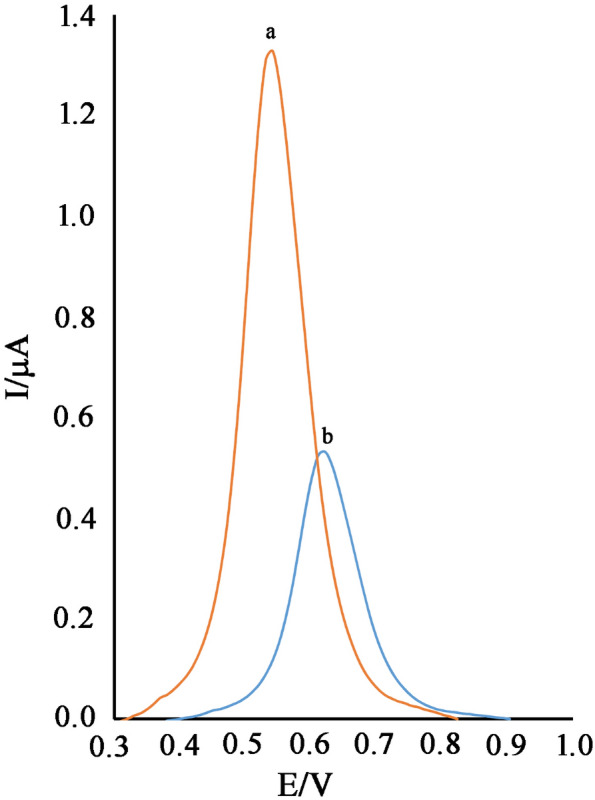
SWVs of carbon paste electrode in the solution containing (a) 500 µM serotonin and (b) 500 µM cysteamine.
Stability and reproducibility
The reproducibility and stability of NiO–Pt–H/B,1,10,P,1,10,PDNiPF6/CPE were investigated by recording SWV of 100.0 µM cysteamine at pH 7.0. We detected a relative standard deviation of (RSD%) 2.1% for five successive recorded signals that confirmed good repeatability for NiO–Pt–H/B,1,10,P,1,10,PDNiPF6/CPE as an electroanalytical sensor. Moreover, the stability of the NiO–Pt–H/B,1,10,P,1,10,PDNiPF6/CPE was examined by the storage of the sensor in the lab. Then, NiO–Pt–H/B,1,10,P,1,10,PDNiPF6/CPE was used for the determination of 100.0 µM cysteamine using SWV. The recorded signal showed 93.2% of its initial response relative to 100.0 µM cysteamine after 60 days, using NiO–Pt–H/B,1,10,P,1,10,PDNiPF6/CPE, indicating good stability for the suggested sensor. To study the reproducibility of NiO–Pt–H/B,1,10,P,1,10,PDNiPF6/CPE in determination of 500 µM cysteamine, five modified electrodes were prepared in the same condition and the oxidation signal of cysteamine was recorded on the surface of NiO–Pt–H/B,1,10,P,1,10,PDNiPF6/CPE with a scan rate of 10 mV/s. A relative standard deviation of (RSD%) 3.33% was detected for the determination of cysteamine on the surface of these electrodes, confirming good reproducibility for the fabrication of NiO–Pt–H/B,1,10,P,1,10,PDNiPF6/CPE (Fig. 10).
Figure 10.
Recorded current for electrooxidation of 500 µM cysteamine on the surface of five different NiO–Pt–H/B,1,10,P,1,10,PDNiPF6/CPEs prepared in the same condition.
Real sample and interference study
The selectivity of NiO–Pt–H/B,1,10,P,1,10,PDNiPF6/CPE as an electroanalytical sensor was checked in the solution containing 20.0 µM cysteamine with an acceptable error of 5% in oxidation current. The results are presented in Table 1 and the data obtained exhibit interesting selection of NiO–Pt–H/B,1,10,P,1,10,PDNiPF6/CPE as an electroanalytical sensor for the determination of cysteamine.
Table 1.
The interference study results in the presence of 20.0 µM cysteamine.
| Species | Tolerant limits (Winterference/Wcysteamine) |
|---|---|
| Cl-, K+, Li+, F-, Mg2+ | 950 |
| Fructose and glucose, ascorbic acid (after addition of 1.0 mM ascorbate oxidase) | 750 |
| Methionine, Dopamine, Valine, Uric acid, vitamin B2 | 300 |
In the final step, we check the ability of NiO–Pt–H/B,1,10,P,1,10,PDNiPF6/CPE as a powerful electroanalytical sensor for determination of cysteamine and serotonin in capsule and pharmaceutical serum samples. The recovery data between 98.5–103.06% for analysis of cysteamine and 98.1–101.68% for analysis of serotonin were observed on the surface of NiO–Pt–H/B,1,10,P,1,10,PDNiPF6/CPE (Table 2), confirming the powerful ability of NiO–Pt–H/B,1,10,P,1,10,PDNiPF6/CPE as a novel and powerful analytical sensor.
Table 2.
Determination of cysteamine and serotonin in real samples (n = 5).
| Samples | Cysteamine standard solution added (µM) | Serotonin standard solution added (µM) | Founded of cysteamine (µM) | Founded of serotonin (µM) | Recovery value % for cysteamine | Recovery value % for serotonin |
|---|---|---|---|---|---|---|
| Cysteamine capsule | – | – | – | 4.95 ± 0.45 | – | – |
| 5.00 | – | 9.83 ± 0.67 | – | 98.79 | – | |
| Pharmaceutical serum | – | – | < LOD | < LOD | – | – |
| 10.00 | 10.00 | 9.85 ± 0.39 | 9.81 ± 0.52 | 98.5 | 98.1 | |
| 15.00 | 45.00 | 15.46 ± 0.59 | 45.76 ± 0.93 | 103.06 | 101.68 |
Conclusion
In this study, a novel and highly sensitive electroanalytical sensor was fabricated for the determination of cysteamine by modification of CPE with NiO–Pt–H and B,1,10,P,1,10,PDNiPF6 as two mediators. The NiO–Pt–H was synthesized by an one-pot procedure resulting in a spherical shape with diameter of 30.64 nm. The NiO–Pt–H/B,1,10,P,1,10,PDNiPF6/CPE was used as the first electrochemical sensor for the simultaneous analysis of cysteamine and serotonin with detection limits of 0.5 nM and 0.1 µM, respectively. In addition, NiO–Pt–H and B,1,10,P,1,10,PDNiPF6 showed a powerful ability for the determination of cysteamine and serotonin in the drug and pharmaceutical serum samples with recovery data of 98.1–103.06%.
Acknowledgements
The authors hereby express their thanks for the support rendered by Nanjing Forestry University (Grant nos. 163020139 and 163020211), Science and Technology Department of Jiangsu Province (BK2020043008) and National Natural Science Foundation of China (5201101466).
Author contributions
H.K.M., F.K., and F.S. organized all experiments and wrote the manuscript.; Y.O., G.M., A.R., and A.A., performed all experiments. They have also drawn the figures.
Competing interests
The authors declare no competing interests.
Footnotes
Publisher's note
Springer Nature remains neutral with regard to jurisdictional claims in published maps and institutional affiliations.
Contributor Information
Hassan Karimi-Maleh, Email: hassan@uestc.edu.cn.
Fatemeh Karimi, Email: fatemeh.karimi@tdtu.edu.vn.
Fatih Sen, Email: fatihsen1980@gmail.com.
References
- 1.Karimi-Maleh H, Biparva P, Hatami M. A novel modified carbon paste electrode based on NiO/CNTs nanocomposite and (9, 10-dihydro-9, 10-ethanoanthracene-11, 12-dicarboximido)-4-ethylbenzene-1, 2-diol as a mediator for simultaneous determination of cysteamine, nicotinamide adenine dinucleotide and folic acid. Biosens. Bioelectron. 2013;48:270–275. doi: 10.1016/j.bios.2013.04.029. [DOI] [PubMed] [Google Scholar]
- 2.Healy J. A trial of cystamine in radiation sickness. Br. J. Radiol. 1960;33(392):512–514. doi: 10.1259/0007-1285-33-392-512. [DOI] [PubMed] [Google Scholar]
- 3.Vecsei L, Kovacs G, Faludi M, Bollok I, Telegdy G. Dose-related effects of cysteamine treatment on hypothalamic and striatal dopamine, noradrenaline and serotonin neurotransmission. Acta Physiol. Hung. 1985;66(2):213–217. [PubMed] [Google Scholar]
- 4.Szabo S, Horner H, Maull H, Schnoor J, Chiueh C, Palkovits M. Biochemical changes in tissue catecholamines and serotonin in duodenal ulceration caused by cysteamine or propionitrile in the rat. J. Pharmacol. Exp. Ther. 1987;240(3):871–878. [PubMed] [Google Scholar]
- 5.Sharma S, Singh N, Tomar V, Chandra R. A review on electrochemical detection of serotonin based on surface modified electrodes. Biosens. Bioelectron. 2018;107:76–93. doi: 10.1016/j.bios.2018.02.013. [DOI] [PubMed] [Google Scholar]
- 6.Koch DD, Kissinger PT. Determination of serotonin in serum and plasma by liquid chromatography with precolumn sample enrichment and electrochemical detection. Anal. Chem. 1980;52(1):27–29. doi: 10.1021/ac50051a008. [DOI] [PubMed] [Google Scholar]
- 7.Satyanarayana M, Koteshwara Reddy K, Vengatajalabathy Gobi K. Nanobiocomposite based electrochemical sensor for sensitive determination of serotonin in presence of dopamine, ascorbic acid and uric acid in vitro. Electroanalysis. 2014;26(11):2365–2372. [Google Scholar]
- 8.Kelly MJ, Perrett D, Rudge SR. The determination of cysteamine in physiological fluids by HPLC with electrochemical detection. Biomed. Chromatogr. 1987;2(5):216–220. doi: 10.1002/bmc.1130020509. [DOI] [PubMed] [Google Scholar]
- 9.Kubalczyk P, Bald E. Method for determination of total cysteamine in human plasma by high performance capillary electrophoresis with acetonitrile stacking. Electrophoresis. 2008;29(17):3636–3640. doi: 10.1002/elps.200800034. [DOI] [PubMed] [Google Scholar]
- 10.Tumur M, Kanberoglu GS, Coldur F. A novel potentiometric PVC-membrane cysteamine-selective electrode based on cysteamine-phosphomolybdate ion-pair. Curr. Pharm. Anal. 2020;16(2):168–175. [Google Scholar]
- 11.Kataoka H, Imamura Y, Tanaka H, Makita M. Determination of cysteamine and cystamine by gas chromatography with flame photometric detection. J. Pharm. Biomed. Anal. 1993;11(10):963–969. doi: 10.1016/0731-7085(93)80056-7. [DOI] [PubMed] [Google Scholar]
- 12.Apyari VV, Dmitrienko SG, Arkhipova VV, Atnagulov AG, Zolotov YA. Determination of cysteamine using label-free gold nanoparticles. Anal. Methods. 2012;4(10):3193–3199. [Google Scholar]
- 13.Rezaei B, Khosropour H, Ensafi AA. Sensitive voltammetric determination of cysteamine using promazine hydrochloride as a mediator and modified multi-wall carbon nanotubes carbon paste electrodes. Ionics. 2014;20(9):1335–1342. [Google Scholar]
- 14.Mollarasouli F, Kurbanoglu S, Ozkan SA. The role of electrochemical immunosensors in clinical analysis. Biosensors. 2019;9(3):86. doi: 10.3390/bios9030086. [DOI] [PMC free article] [PubMed] [Google Scholar]
- 15.S. Kaya, B. Demirkan, N. Bakirhan, E. Kuyuldar, S. Kurbanoglu, S. Ozkan, F. Sen, Highly sensitive carbon-based nanohybrid sensor platform for determination of 5-hydroxytryptamine receptor agonist (Eletriptan). J. Pharmaceut. Biomed. Anal. (2019). [DOI] [PubMed]
- 16.H. Karimi‐Maleh, F. Karimi, M. Alizadeh, A.L. Sanati, Electrochemical sensors, a bright future in the fabrication of portable kits in analytical systems. Chem. Rec. 20. 10.1002/tcr.201900092 (2020). [DOI] [PubMed]
- 17.Soltani H, Beitollahi H, Hatefi-Mehrjardi A-H, Tajik S, Torkzadeh-Mahani M. Voltammetric determination of glutathione using a modified single walled carbon nanotubes paste electrode. Anal. Bioanal. Electrochem. 2014;6(1):67–79. [Google Scholar]
- 18.Beitollahi H, Dourandish Z, Tajik S, Ganjali MR, Norouzi P, Faridbod F. Application of graphite screen printed electrode modified with dysprosium tungstate nanoparticles in voltammetric determination of epinephrine in the presence of acetylcholine. J. Rare Earths. 2018;36(7):750–757. [Google Scholar]
- 19.Motaghi MM, Beitollahi H, Tajik S, Hosseinzadeh R. Nanostructure electrochemical sensor for voltammetric determination of vitamin C in the presence of vitamin B6: Application to real sample analysis. Int. J. Electrochem. Sci. 2016;11:7849–7860. [Google Scholar]
- 20.Baghbamidi SE, Beitollahi H, Tajik S, Hosseinzadeh R. Voltammetric sensor based on 1-benzyl-4-ferrocenyl-1H-[1, 2, 3]-triazole/carbon nanotube modified glassy carbon electrode; detection of hydrochlorothiazide in the presence of propranolol. Int. J. Electrochem. Sci. 2016;11(12):10874–10883. [Google Scholar]
- 21.Bakirhan NK, Ozcelikay G, Ozkan SA. Recent progress on the sensitive detection of cardiovascular disease markers by electrochemical-based biosensors. J. Pharm. Biomed. Anal. 2018;159:406–424. doi: 10.1016/j.jpba.2018.07.021. [DOI] [PubMed] [Google Scholar]
- 22.Keyvanfard M, Ahmadi M, Karimi F, Alizad K. Voltammetric determination of cysteamine at multiwalled carbon nanotubes paste electrode in the presence of isoproterenol as a mediator. Chin. Chem. Lett. 2014;25(9):1244–1246. [Google Scholar]
- 23.Mazloum-Ardakani M, Beitollahi H, Amini MK, Mirkhalaf F, Mirjalili B-F, Akbari A. Application of 2-(3, 4-dihydroxyphenyl)-1, 3-dithialone self-assembled monolayer on gold electrode as a nanosensor for electrocatalytic determination of dopamine and uric acid. Analyst. 2011;136(9):1965–1970. doi: 10.1039/c0an00823k. [DOI] [PubMed] [Google Scholar]
- 24.Karimi-Maleh H, Tahernejad-Javazmi F, Ensafi AA, Moradi R, Mallakpour S, Beitollahi H. A high sensitive biosensor based on FePt/CNTs nanocomposite/N-(4-hydroxyphenyl)-3, 5-dinitrobenzamide modified carbon paste electrode for simultaneous determination of glutathione and piroxicam. Biosens. Bioelectron. 2014;60:1–7. doi: 10.1016/j.bios.2014.03.055. [DOI] [PubMed] [Google Scholar]
- 25.Ensafi AA, Karimi-Maleh H, Mallakpour S. Simultaneous determination of ascorbic acid, acetaminophen, and tryptophan by square wave voltammetry using N-(3, 4-dihydroxyphenethyl)-3, 5-dinitrobenzamide-modified carbon nanotubes paste electrode. Electroanalysis. 2012;24(3):666–675. [Google Scholar]
- 26.Ensafi AA, Maleh HK. A multiwall carbon nanotubes paste electrode as a sensor and ferrocenemonocarboxylic acid as a mediator for electrocatalytic determination of isoproterenol. Int. J. Electrochem. Sci. 2010;5:1484–1495. [Google Scholar]
- 27.Raoof JB, Ojani R, Karimi-Maleh H, Hajmohamadi MR, Biparva P. Multi-wall carbon nanotubes as a sensor and ferrocene dicarboxylic acid as a mediator for voltammetric determination of glutathione in hemolysed erythrocyte. Anal. Methods. 2011;3(11):2637–2643. [Google Scholar]
- 28.Ensafi AA, Karimi-Maleh H. A voltammetric sensor based on modified multiwall carbon nanotubes for cysteamine determination in the presence of tryptophan using p-aminophenol as a mediator. Electroanalysis. 2010;22(21):2558–2568. [Google Scholar]
- 29.Karimi-Maleh H, Ensafi AA, Ensafi HR. Ferrocenedicarboxylic acid modified carbon paste electrode: A sensor for electrocatalytic determination of hydrochlorothiazide. J. Braz. Chem. Soc. 2009;20(5):880–887. [Google Scholar]
- 30.Karimi-Maleh H, Cellat K, Arıkan K, Savk A, Karimi F, Şen F. Palladium-Nickel nanoparticles decorated on functionalized-MWCNT for high precision non-enzymatic glucose sensing. Mater. Chem. Phys. 2020;250:123042. [Google Scholar]
- 31.Ensafi AA, Karimi-Maleh H, Mallakpour S. N-(3, 4-dihydroxyphenethyl)-3, 5-dinitrobenzamide-modified multiwall carbon nanotubes paste electrode as a novel sensor for simultaneous determination of penicillamine, uric acid, and tryptophan. Electroanalysis. 2011;23(6):1478–1487. [Google Scholar]
- 32.Ensafi A, Karimi-Maleh H, Mallakpour S. A new strategy for the selective determination of glutathione in the presence of nicotinamide adenine dinucleotide (NADH) using a novel modified carbon nanotube paste electrode. Colloids Surf. B. 2013;104:186–193. doi: 10.1016/j.colsurfb.2012.12.011. [DOI] [PubMed] [Google Scholar]
- 33.Ensafi AA, Dadkhah-Tehrani S, Karimi-Maleh H. A voltammetric sensor for the simultaneous determination of L-cysteine and tryptophan using a p-aminophenol-multiwall carbon nanotube paste electrode. Anal. Sci. 2011;27(4):409–409. doi: 10.2116/analsci.27.409. [DOI] [PubMed] [Google Scholar]
- 34.Raoof J-B, Ojani R, Baghayeri M. Simultaneous electrochemical determination of glutathione and tryptophan on a nano-TiO2/ferrocene carboxylic acid modified carbon paste electrode. Sens. Actuators B Chem. 2009;143(1):261–269. [Google Scholar]
- 35.Karimi-Maleh H, Tahernejad-Javazmi F, Daryanavard M, Hadadzadeh H, Ensafi AA, Abbasghorbani M. Electrocatalytic and simultaneous determination of ascorbic acid, nicotinamide adenine dinucleotide and folic acid at ruthenium (II) complex-ZnO/CNTs nanocomposite modified carbon paste electrode. Electroanalysis. 2014;26(5):962–970. [Google Scholar]
- 36.Karimi-Maleh H, Ahanjan K, Taghavi M, Ghaemy M. A novel voltammetric sensor employing zinc oxide nanoparticles and a new ferrocene-derivative modified carbon paste electrode for determination of captopril in drug samples. Anal. Methods. 2016;8(8):1780–1788. [Google Scholar]
- 37.Baghayeri M, Rouhi M, Lakouraj MM, Amiri-Aref M. Bioelectrocatalysis of hydrogen peroxide based on immobilized hemoglobin onto glassy carbon electrode modified with magnetic poly (indole-co-thiophene) nanocomposite. J. Electroanal. Chem. 2017;784:69–76. [Google Scholar]
- 38.Shabani-Nooshabadi M, Tahernejad-Javazmi F. Electrocatalytic determination of hydroxylamine in the presence of thiosulfate in water and wastewater samples using a nanostructure modified carbon paste electrode. Electroanalysis. 2015;27(7):1733–1741. [Google Scholar]
- 39.Shabani-Nooshabadi M, Tahernejad-Javazmi F. Rapid and fast strategy for the determination of glutathione in the presence of vitamin B 6 in biological and pharmaceutical samples using a nanostructure based electrochemical sensor. RSC Adv. 2015;5(69):56255–56261. [Google Scholar]
- 40.Tahernejad-Javazmi F, Shabani-Nooshabadi M. Voltammetric determination of thiosulfate in presence of p-nitrophenol using an electrochemical nanostructure sensor modified with a new mediator. J. Electrochem. Soc. 2017;164(13):H975–H980. [Google Scholar]
- 41.Baghayeri M, Namadchian M, Karimi-Maleh H, Beitollahi H. Determination of nifedipine using nanostructured electrochemical sensor based on simple synthesis of Ag nanoparticles at the surface of glassy carbon electrode: Application to the analysis of some real samples. J. Electroanal. Chem. 2013;697:53–59. [Google Scholar]
- 42.Shabani-Nooshabadi M, Roostaee M, Tahernejad-Javazmi F. Graphene oxide/NiO nanoparticle composite-ionic liquid modified carbon paste electrode for selective sensing of 4-chlorophenol in the presence of nitrite. J. Mol. Liq. 2016;219:142–148. [Google Scholar]
- 43.Fouladgar M, Hadjmohammadi MR, Khalilzadeh MA, Biparva P, Teymoori N, Beitollah H. Voltammetric determination of amoxicillin at the electrochemical sensor ferrocenedicarboxylic acid multi wall carbon nanotubes paste electrode. Int. J. Electrochem. Sci. 2011;6:1355–1366. [Google Scholar]
- 44.Fouladgar M. Electrocatalytic measurement of trace amount of captopril using multiwall carbon nanotubes as a sensor and ferrocene as a mediator. Int. J. Electrochem. Sci. 2011;6:705–716. [Google Scholar]
- 45.Golikand AN, Raoof J, Baghayeri M, Asgari M, Irannejad L. Nickel electrode modified by N, N-bis (salicylidene) phenylenediamine (Salophen) as a catalyst for methanol oxidation in alkaline medium. Russ. J. Electrochem. 2009;45(2):192–198. [Google Scholar]
- 46.Maleki B, Baghayeri M. Synthesis of symmetrical N, N′-alkylidene bis-amides catalyzed by silica coated magnetic NiFe2O4 nanoparticle supported polyphosphoric acid (NiFe2O4 @ SiO2-PPA) and its application toward silver nanoparticle synthesis for electrochemical detection of glucose. RSC Adv. 2015;5(97):79746–79758. [Google Scholar]
- 47.Li Y, Ji Y, Ren B, Jia L, Ma G, Liu X. Carboxyl-functionalized mesoporous molecular sieve/colloidal gold modified nano-carbon ionic liquid paste electrode for electrochemical determination of serotonin. Mater. Res. Bull. 2019;109:240–245. [Google Scholar]
- 48.Fouladgar M. CuO-CNT nanocomposite/ionic liquid modified sensor as new breast anticancer approach for determination of doxorubicin and 5-fluorouracil drugs. J. Electrochem. Soc. 2018;165(13):B559–B564. [Google Scholar]
- 49.Lu Y, Li X, Zhang L, Yu P, Su L, Mao L. Aptamer-based electrochemical sensors with aptamer—Complementary DNA oligonucleotides as probe. Anal. Chem. 2008;80(6):1883–1890. doi: 10.1021/ac7018014. [DOI] [PubMed] [Google Scholar]
- 50.Kwon H, Chan KM, Kool ET. DNA as an environmental sensor: Detection and identification of pesticide contaminants in water with fluorescent nucleobases. Org. Biomol. Chem. 2017;15(8):1801–1809. doi: 10.1039/c6ob02830f. [DOI] [PMC free article] [PubMed] [Google Scholar]
- 51.Feng K-J, Yang Y-H, Wang Z-J, Jiang J-H, Shen G-L, Yu R-Q. A nano-porous CeO2/chitosan composite film as the immobilization matrix for colorectal cancer DNA sequence-selective electrochemical biosensor. Talanta. 2006;70(3):561–565. doi: 10.1016/j.talanta.2006.01.009. [DOI] [PubMed] [Google Scholar]
- 52.Jahandari S, Taher MA, Karimi-Maleh H, Mansouri G. Simultaneous voltammetric determination of glutathione, doxorubicin and tyrosine based on the electrocatalytic effect of a nickel (II) complex and of Pt:Co nanoparticles as a conductive mediator. Microchim. Acta. 2019;186(8):493. doi: 10.1007/s00604-019-3598-z. [DOI] [PubMed] [Google Scholar]
- 53.Baghayeri M. Pt nanoparticles/reduced graphene oxide nanosheets as a sensing platform: Application to determination of droxidopa in presence of phenobarbital. Sens. Actuators B Chem. 2017;240:255–263. [Google Scholar]
- 54.Veisi H, Eshbala FH, Hemmati S, Baghayeri M. Selective hydrogen peroxide oxidation of sulfides to sulfones with carboxylated multi-walled carbon nano tubes (MWCNTs-COOH) as heterogeneous and recyclable nanocatalysts under organic solvent-free conditions. RSC Adv. 2015;5(14):10152–10158. [Google Scholar]
- 55.Beitollahi H, Tajik S, Mohammadi SZ, Baghayeri M. Voltammetric determination of hydroxylamine in water samples using a 1-benzyl-4-ferrocenyl-1H-[1, 2, 3]-triazole/carbon nanotube-modified glassy carbon electrode. Ionics. 2014;20(4):571–579. [Google Scholar]
- 56.Baghayeri M, Veisi H, Veisi H, Maleki B, Karimi-Maleh H, Beitollahi H. Multi-walled carbon nanotubes decorated with palladium nanoparticles as a novel platform for electrocatalytic sensing applications. RSC Adv. 2014;4(91):49595–49604. [Google Scholar]
- 57.Khalilzadeh MA, Karimi-Maleh H, Amiri A, Gholami F. Determination of captopril in patient human urine using ferrocenemonocarboxylic acid modified carbon nanotubes paste electrode. Chin. Chem. Lett. 2010;21(12):1467–1470. [Google Scholar]
- 58.Fu L, Wu M, Zheng Y, Zhang P, Ye C, Zhang H, Wang K, Su W, Chen F, Yu J. Lycoris species identification and infrageneric relationship investigation via graphene enhanced electrochemical fingerprinting of pollen. Sens. Actuators B Chem. 2019;298:126836. [Google Scholar]
- 59.Yuan B, Sun P, Zhao L-J, Zhang D, Zhang Y, Qi C, Niu Y, Xu H, Xu C. Pd nanoparticles supported on 1, 10-phenanthroline-5, 6-dione modified graphene oxide as superior bifunctional electrocatalyst for highly sensitive sensing. J. Electroanal. Chem. 2020;861:113945. [Google Scholar]
- 60.Baghayeri M, Mahdavi B, Hosseinpor-Mohsen Abadi Z, Farhadi S. Green synthesis of silver nanoparticles using water extract of Salvia leriifolia: Antibacterial studies and applications as catalysts in the electrochemical detection of nitrite. Appl. Organomet. Chem. 2018;32(2):e4057. [Google Scholar]
- 61.Maleki B, Baghayeri M, Abadi SAJ, Tayebee R, Khojastehnezhad A. Ultrasound promoted facile one pot synthesis of highly substituted pyran derivatives catalyzed by silica-coated magnetic NiFe2O4 nanoparticle-supported H 14 [NaP 5 W 30 O 110] under mild conditions. RSC Adv. 2016;6(99):96644–96661. [Google Scholar]
- 62.Baghayeri M, Amiri A, Alizadeh Z, Veisi H, Hasheminejad E. Non-enzymatic voltammetric glucose sensor made of ternary NiO/Fe3O4-SH/para-amino hippuric acid nanocomposite. J. Electroanal. Chem. 2018;810:69–77. [Google Scholar]
- 63.Baghayeri M, Maleki B, Zarghani R. Voltammetric behavior of tiopronin on carbon paste electrode modified with nanocrystalline Fe50Ni50 alloys. Mater. Sci. Eng. C. 2014;44:175–182. doi: 10.1016/j.msec.2014.08.023. [DOI] [PubMed] [Google Scholar]
- 64.Sadeghi R, Karimi-Maleh H, Bahari A, Taghavi M. A novel biosensor based on ZnO nanoparticle/1, 3-dipropylimidazolium bromide ionic liquid-modified carbon paste electrode for square-wave voltammetric determination of epinephrine. Phys. Chem. Liq. 2013;51(6):704–714. [Google Scholar]
- 65.Alavi-Tabari SA, Khalilzadeh MA, Karimi-Maleh H. Simultaneous determination of doxorubicin and dasatinib as two breast anticancer drugs uses an amplified sensor with ionic liquid and ZnO nanoparticle. J. Electroanal. Chem. 2018;811:84–88. [Google Scholar]
- 66.Yuan B, Xu C, Deng D, Xing Y, Liu L, Pang H, Zhang D. Graphene oxide/nickel oxide modified glassy carbon electrode for supercapacitor and nonenzymatic glucose sensor. Electrochim. Acta. 2013;88:708–712. [Google Scholar]
- 67.A. Dehdashti, A. Babaei, Highly sensitive electrochemical sensor based on Pt doped NiO nanoparticles/MWCNTs nanocomposite modified electrode for simultaneous sensing of piroxicam and amlodipine. Electroanalysis.
- 68.V. Arabali, S. Malekmohammadi, F. Karimi, Surface amplification of pencil graphite electrode using CuO nanoparticle/polypyrrole nanocomposite; A powerful electrochemical strategy for determination of tramadol. Microchem. J. 105179 (2020).
- 69.Hojjati-Najafabadi A, Rahmanpour MS, Karimi F, Zabihi-Feyzaba H, Malekmohammad S, Agarwal S, Gupta VK, Khalilzadeh MA. Determination of tert-butylhydroquinone using a nanostructured sensor based on CdO/SWCNTs and ionic liquid. Int. J. Electrochem. Sci. 2020;15:6969–6980. [Google Scholar]
- 70.H. Karimi-Maleh, F. Karimi, S. Malekmohammadi, N. Zakariae, R. Esmaeili, S. Rostamnia, M.L. Yola, N. Atar, S. Movagharnezhad, S. Rajendran, An amplified voltammetric sensor based on platinum nanoparticle/polyoxometalate/two-dimensional hexagonal boron nitride nanosheets composite and ionic liquid for determination of N-hydroxysuccinimide in water samples. J. Mol. Liq. (2020).



